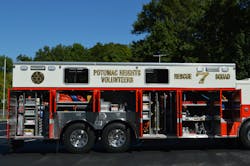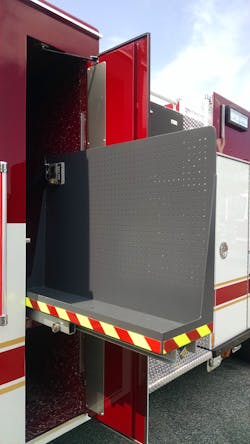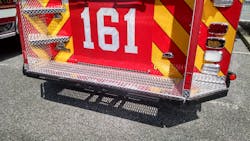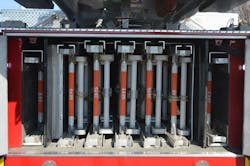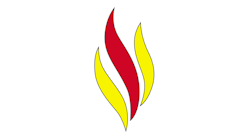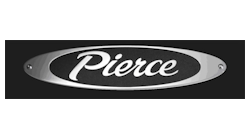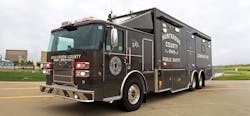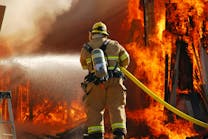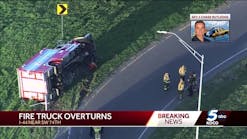Each year, as the fire exhibitions and hands-on training seminars wind down, it provides an opportunity to review and assess changes in fire apparatus design and how they influence our day-to-day operations. No doubt there has been increased emphasis on purchasing multi-purpose apparatus as staffing levels continue to impact our ability on service delivery.
While quint and rescue/engine vehicles are more prevalent, heavy rescue apparatus are often being equipped with small capacity pumps and water tanks to provide fire suppression capability at incidents. Many of these designs ultimately result in longer and heavier vehicles with drastically different handling characteristics when compared to the older units they are replacing.Some innovations are driven by the apparatus manufacturers as a result of research and development programs, while others are regionally developed based upon major department operational requirements. Finally, the really unique advancements often result from vehicle detailing and equipment mounting that is conducted post-delivery by department shops and outside vendors who specialize in vehicle upfitting.
Clean cab concept
One of the current trends in cab design is due to the increasing cancer-related illnesses suffered by many brother and sister fire personnel, resulting in different variations of the clean cab concept. While controversial to some, the goal here is to remove some of the hazards that are inherent with storing PPE, tools and equipment, which have not been properly cleaned and decontaminated, from the cab interior. There are many strategies to introduce a clean cab concept into your operations, including the use of easy-to-clean or replacement seating material, interior walls and ceiling finish, use of aluminum tread plate on cab floors and stepping surfaces along with enhanced heating and air conditioning filtration systems.The Howard County, MD, Fire and Rescue Department has recently placed into service the first of three clean cab pumpers that incorporate many of these features, including exterior cab compartment storage for SCBA and a pump-panel heated shower. The first unit, a 2019 KME Severe Service cab is built with a 191-inch wheelbase, overall length of 31 feet, 6 inches and is equipped with a 1,500-gpm pump, 500-gallon water tank along with a 30-gallon foam cell. Howard County has several other pumpers on order from other manufacturers that will permit vehicle operational, repair and maintenance costs to be monitored for life cycle cost analysis.
Safety precautions
Preconstruction meetings are one of the most important periods after the new apparatus is placed on order, as this is the time when subtle changes can be made to the vehicle design without having a great impact on the overall cost. For example, safe-stepping surfaces can be enhanced by using aggressive, non-slip inserts with fabricated corner steps or an access ladder being preferable to multiple folding steps. These details may not be readily identified reading through the specifications and may require looking at a similar or identical size body and hosebed layout to determine the optimal step arrangement. This is particularly important on heavy Class 8 conventional chassis where the standard step configuration may not work or meet the intent of the NFPA 1901 Standard for step heights.Many rescue/engine designs use a straight vertical rear-body panel, which presents challenges for providing safe access to the hosebed and upper body compartments. Pay attention to the height of the hosebed from the ground to the bottom of the hosebed and consider, where possible, an L-shaped water tank along with a smaller height rear-body compartment. This will provide a lower hosebed, which along with properly sized hosebed dividers, can enhance engine company operations for deploying attack and supply lines safely.
Another preconstruction meeting item that is often overlooked is to review the layout of all gauges, controls and instrumentation on the pump panels. Most manufacturers have standard locations where components would be located, however, certain controls within reason can be positioned to match other units in the fleet to assist in operator training. Departments that frequently draft from portable ponds or other static water supplies should consider using multiple primer taps on the principal suction inlets to assist in drafting operations. Controls for these devices should be located adjacent to the valve controller, labeled and color coded to indicate their operation.
Over the past few years, fire departments have recognized that, with respect to truck company operations, the NFPA 1901 Standard compliment of 115 feet of ground ladders is inadequate to safely and effectively ladder on all four sides of a structure. Unless your response district is primarily trailer parks, carrying only two extension ladders on your quint or ladder truck will not get the job done. With the proliferation of single-axle quint apparatus, many of these units lack sufficient space to carry ground ladders with a single three-section 35-foot and 24-foot extension ladders being the longest ladders on this type of rig.Much like an engine company apparatus is designed around a combination of the body compartments, water tank size and hosebed requirements, any aerial device, regardless of configuration, needs to carry a wide assortment of portable ladders, sufficient in quantity and length to cover all four sides of a building. Some departments are now outfitting their truck companies with ground ladder compliments that utilize both rear-mounted and side-stacked ladders to provide adequate ground ladders to reflect the types of buildings within their response district.
Weighty issues
Some apparatus innovations are the result of day-to-day routines in busy companies where a combination of staffing levels and equipment locations impact safe and efficient operations. Tool and equipment mounting is an art onto itself, which can be accomplished using a variety of resources, including at the manufacturer’s facility, department shops or outside vendors that work on upfitting new apparatus. The days of determining where equipment is going to be carried on rigs after delivery are gone as the required compartment space and associated weight impact on the vehicle’s in-service weight need to be determined prior to contract and confirmed with an engineering weight analysis at the pre-construction conference.
Engine company apparatus can carry between 1,500 to 2,000 pounds of tools and equipment, including tools carried inside of the cab, front bumper, areas above the fire pump and water tank, along with the enclosed body compartments. Special service apparatus equipment weights can range from 2,000 to more than 10,000 pounds of equipment. From practical experience it is not difficult for tandem axle rescue squad apparatus to carry over 14,000 pounds of tools and equipment, all of which must be accounted for when determining where each piece of equipment will be carried on the vehicle.Section 12.1.3 of the NFPA 1901 Standard reads: “The manufacturer shall engineer and design the fire apparatus such that the completed apparatus, when loaded to its estimated in-service weight, with all movable weights distributed as close as is practical to their intended in-service configuration, does not exceed the Gross Vehicle Weight Rating (GVWR).” The apparatus builder must rely upon the fire department to provide an accurate estimate of the equipment cache that is going to be carried on the vehicle. Failing this information, how could a manufacturer accurately determine what size axles, tires and suspension to propose if it did not estimate how much the rig is going to weigh? Besides determining a GVWR for both axles, a detailed weight analysis is necessary to ensure side-to-side weights and front-to-rear axle weights are within acceptable parameters.
Overweight fire apparatus is more common than you might believe, and they are not relegated to older units with marginal axle capacities. Combination apparatus, particularly single-axle quints and rescue/engine units can easily become overloaded as the balance between the weight of fire pump components, water tank, body compartmentation, on-board generators and other systems all impact the vehicle weight and center of gravity concerns. Many units look fine on paper but prove to be problematic once they are outfitted and placed into service.
Think before you act
Innovations come in many variations and some of the best are home-grown solutions from department members and maintenance personnel with first-hand operational experience. Learning from other departments’ first-hand experience with new components can provide valuable insight when considering these designs for your new apparatus. Apparatus committees should review current apparatus trends and take whatever concepts that can improve the safety and reliability of your vehicle fleet. Don’t get caught up in purchasing an apparatus simply because a neighboring jurisdiction acquired one. Do your homework and always ensure that the design concepts meet the mission requirements for the new rig.
